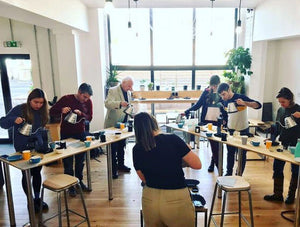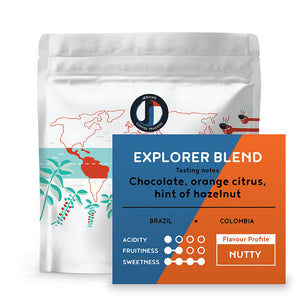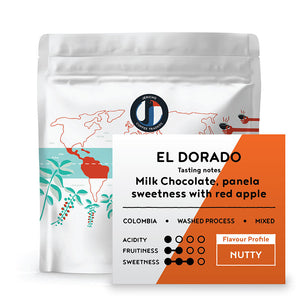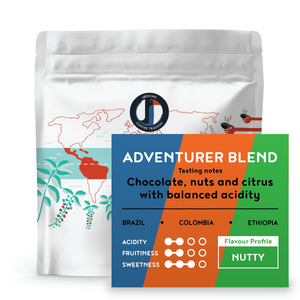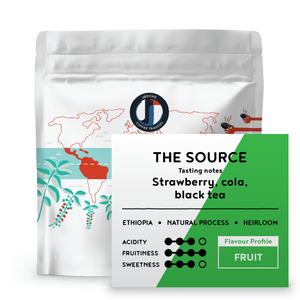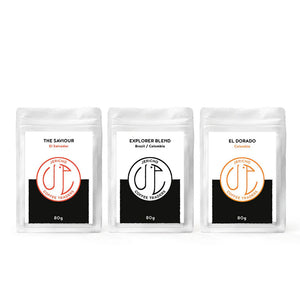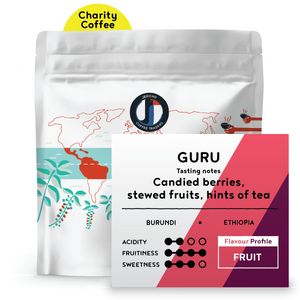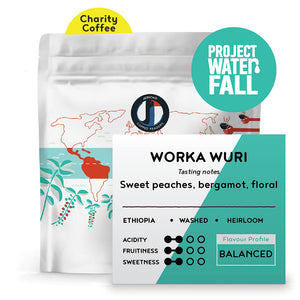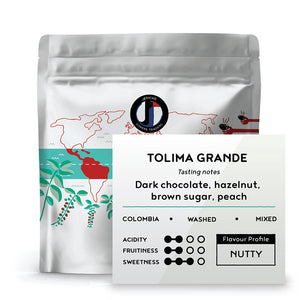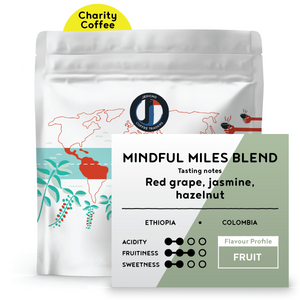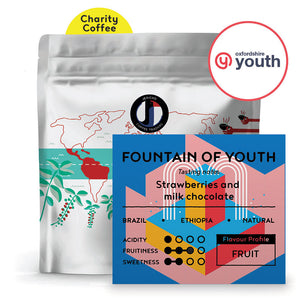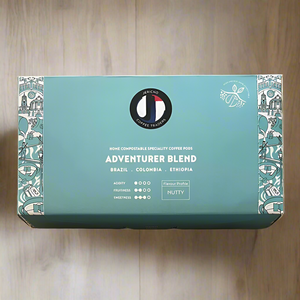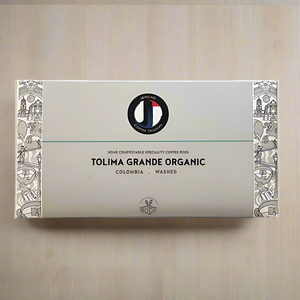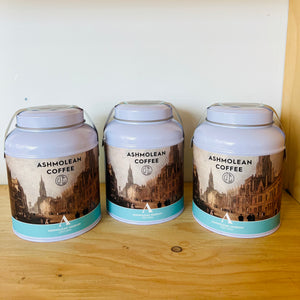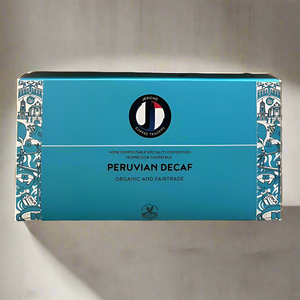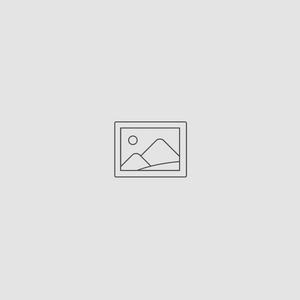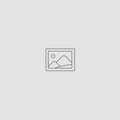Coffee grind size: How it affects extraction & flavour
Aug 20, 2024
When it comes to brewing your favourite coffee, the grind size of your beans will be an essential factor in determining how your coffee extracts and tastes. Whether you're an espresso enthusiast, a fan of the AeroPress, or enjoy your morning cup of coffee from a cafetière, understanding the different grind sizes and their importance can take your coffee experience to a whole new level.
If you don't have a suitable grinder or want to avoid this extra step before you brew, you must buy your coffee pre-ground. However, it must be the correct grind size for your preferred brewing method; otherwise, you won't extract the best possible flavour from the coffee.
Although we always recommend purchasing a grinder to be able to enjoy your coffee at peak freshness since coffee goes stale more quickly once it has been ground, we do provide grinding services if you are not quite ready to take that leap.
All our coffees can be purchased as whole beans or as a specific grind type that covers the most popular brewing methods, such as espresso, Moka pot, AeroPress, V60, filter, and cafetière (we even have a reusable pod grind).
So, whether you grind your own beans at home or buy pre-ground, there are a few things you need to consider that I'll cover below.
Why Grind Size Matters
The grind size of coffee beans affects the extraction process, which is how water interacts with the coffee grounds to extract flavours, oils, and aromas. The size of the grind influences how easily accessible the soluble compounds in the coffee are, which impacts the extraction rate and the taste of your coffee.
Here's why grind size is so important:
- Surface Area. Finer grinds have more surface area, which means water has more contact with the coffee during brewing. This increases the extraction rate.
- Extraction Time. Different brewing methods require different extraction times. Finer grinds extract quickly, while coarser grinds require a longer time.
- Flavour Balance. The right grind size ensures a balanced extraction, preventing under-extraction (for a sour, weak flavour) or over-extraction (for a bitter, harsh flavour).
In short, grind size is one of the many variables we use to control the level of extraction in our brew. Typically, we aim for an 18-22% extraction percentage when brewing coffee, i.e. we want to dissolve about 18-22% of the total coffee mass into our brew.
There are several different ways to control the level of extraction, such as changing the water temperature, brew ratio, brew time, agitation, and more. The fact that there are so many ways to achieve the desired level of extraction is why there are lots of brewing methods. Each brewing method allows us to consistently brew great-tasting coffee using pre-determined recipes or frameworks. As previously mentioned, the grind size is a vital component of this recipe!
Now, let's look at the different grind sizes and how they apply to specific brewing methods.
Espresso
Grind size: fine
Espresso is a concentrated coffee brewed by forcing hot water through finely-ground coffee under high pressure. When we brew espresso we use a low brew ratio, usually around 1:2 coffee to water, so we need to use a very fine grind to achieve the desired extraction percentage.
The low ratio means less extraction, so we must compensate for that with the grind size. The grind for espresso needs to be very fine, resembling the texture of powdered sugar. This fine grind allows the water to adequately extract the coffee despite the small amount of water used.
The high pressure is necessary to allow the water to pass through the extremely finely ground bed of coffee, which provides much resistance to the flow of water.
If the grind is too coarse, the water will flow too quickly, resulting in under-extraction. On the other hand, if the grind is too fine, the water may struggle to pass through, leading to over-extraction.
Moka Pot
Grind size: fine
The Moka pot, often called a stovetop, brews coffee by passing boiling water pressurised by steam through ground coffee. The grind size for a Moka pot should be slightly coarser than that for an espresso machine - think of a texture similar to fine sand.
A slightly coarser grind is necessary because the pressure in a Moka pot is lower than in an espresso machine. Too fine a grind could cause clogging, leading to a bitter coffee or even damage to the pot. To compensate for this, Moka pot recipes will use a higher brew ratio to achieve the desired extraction.
AeroPress
Grind size: medium-fine
The AeroPress is a versatile brewing method that can accommodate various grind sizes depending on your desired coffee strength and brew time. We recommend a medium to fine grind, similar in texture to table salt.
The AeroPress is the first brewing method here that uses immersion, where the grounds and brewing water are mixed and left to sit. Both the Mokka Pot and espresso brewing methods use percolation, where the water is passed through the coffee grounds, and the contact time is typically only 20-35 seconds.
The AeroPress is actually a hybrid between an immersion and percolation brewer and is extremely versatile. Finding the perfect grind depends on the intended recipe. However, the medium-fine grind size is typically a good bet!
Compared to the Moka pot and the espresso machine, the immersion aspect of the Aero Press increases the level of extraction due to a prolonged contact time. This is what allows us to use an even coarser grind than the Mokka Pot while still using a similar brew ratio.
We usually work with an AeroPress brew time of about 1-2 minutes. Additional extraction occurs at the end of the immersion phase when we press the water through the grinds. That develops pressure inside the brewer and introduces agitation.
V60 (Pour Over)
Grind Size: Medium
The V60 is a popular pour-over method that requires a medium grind size, similar to granulated sugar. This percolation method involves pouring hot water over the coffee grounds and allowing the coffee to drip through a filter.
For the V60 we typically use a medium grind size, using the pouring of the water to add agitation and an extended contact time of 2-3 minutes. If the grind is too fine, the water will drain too slowly, leading to over-extraction and excessive bitterness. If it's too coarse, the water will pass through too quickly, causing under-extraction and a weak, sour taste.
Filter (Drip Coffee Maker)
Grind size: medium-course
A medium-course grind is usually the best option for a standard drip coffee maker. The drip coffee maker is essentially just a scaled-up version of the V60 and requires a courser grind to allow the water to pass through the thicker bed of coffee.
Drip coffee makers typically have longer brew times, around 4-6 minutes. A medium grind allows the water to extract the flavours evenly during this time. The medium-course grind is the sweet spot for achieving a well-balanced cup of drip coffee.
Cafetière (French Press)
Grind size: medium-coarse
The cafetière, or French press, is a full-immersion brewing method in which coffee grounds are steeped in hot water before being separated by a metal or nylon mesh filter. The grind size for a French press should be similar to that of a drip coffee maker: medium-coarse.
The French Press also uses a longer contact time to reach the desired extraction at a courser grind size. Using a brew time of 4+ minutes is recommended, and steeping a French Press for too long is not really possible. This is because in an immersion technique, we are not continuously introducing fresh water. At about the 4-minute mark, the brewing water is mostly saturated with solubles, halting the extraction process. This makes the contact time a constant, so the grind size becomes the only way of increasing or decreasing the extraction percentage.
A grind that is too fine will lead to over-extraction, resulting in a bitter, muddy cup. Conversely, a too coarse grind will make the water saturated before the grounds extract adequately, leading to a sour, weak, under-extracted brew.
An additional consideration is that the mesh filter of a French press isn't as fine as paper filters, so a coarse grind helps prevent sediment from ending up in your cup, which ensures a cleaner brew.
Wrapping up your grind...
The grind size of your coffee beans is not just a minor detail; it's a fundamental aspect that can dramatically influence the quality of your coffee.
The grind size must be dialled in for each brewing method - espresso, Moka pot, AeroPress, V60, filter, and cafetière - to achieve a balanced extraction for your intended recipe.
The benefit of owning a grinder at home is full control over this essential variable which allows you to tailor the grind size to your specific brewing style and preferences. However, if you prefer to order pre-ground, each of our speciality coffees is provided with a grind size that will suit your chosen brewing method.
So, the next time you're preparing your favourite brew, pay close attention to the grind size - whether you're grinding your own beans or purchasing pre-ground coffee. It's the key to unlocking the full potential of your speciality coffee beans and enjoying a truly exceptional coffee experience.
For more on perfecting your brew, read our guides on "How to brew your coffee" and "Mastering the perfect coffee micro-foam"




